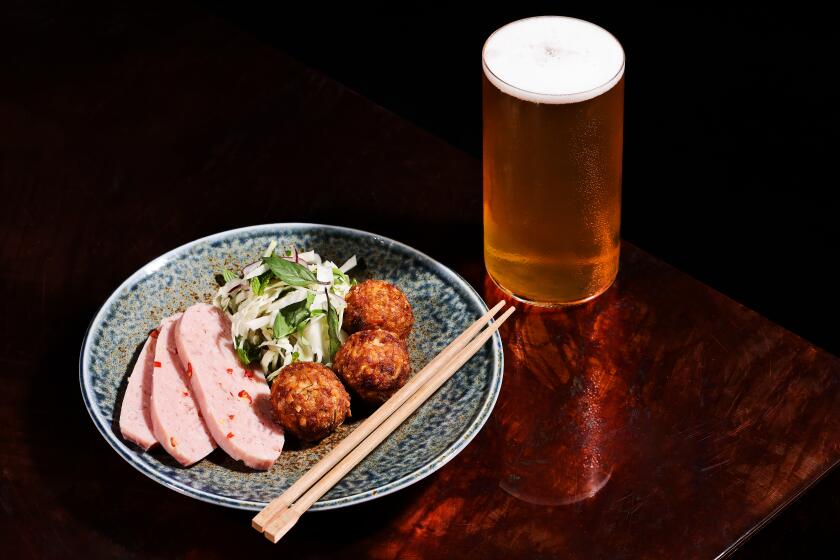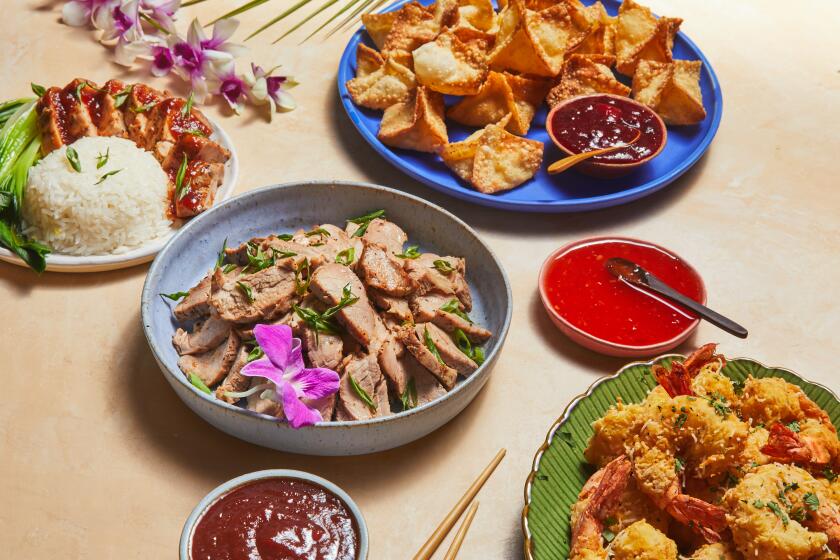The secret to great ceviche from the chef of the world’s No. 1 restaurant

The beauty of freeze-dried potatoes. Citron for Sukkot. Pop-Tart inspiration. I’m Laurie Ochoa, general manager of L.A. Times Food, with this week’s Tasting Notes.
Essential tastes
“I have done hundreds of cooking demonstrations and in 12 years, I have never seen so many ingredients on the stage.”
Gregory Schaefer, host of the L.A. Times Food Stage going back to the Night Market at the first L.A. Times Food Bowl in 2017, watched in amazement last Friday as Virgilio Martinez, chef of Central, currently No. 1 on the World’s 50 Best list, set out an array of foods from his home in Peru. There were cacao pods of all sizes; a rainbow assortment of potatoes and other knobby tubers, including oca, olluco and mashua; herbs, fruits and grains from the Andes and the Amazon; and fresh seafood from Southern California, including gorgeous sea urchin from diver Stephanie Mutz. Oh, and there were also several lumps of damp clay.
Given that more than 250 ingredients go into the 14-course menu Martinez serves at Central — detailed in my recent story about the chef — it shouldn’t have been a surprise that he would want to show off some of Peru’s bounty.
With a packed Night Market crowd around the stage, Martinez along with Marvic Medina, the woman who is Martinez’s head chef at Central in Lima, plus special projects director Maca Pottage, set about giving the audience a crash course in Peruvian ecosystems while making a quick ceviche and showing what you can do with freeze-dried potatoes. I was lucky enough to get an up-close view of the action on stage.
Let’s start with those freeze-dried potatoes, better known in Peru as chuño. They are much lighter to hold than you might imagine from their size — a result of the chalk-white chuño being dried under the sun.
“They get frozen in the mountains,” Martinez said. “It’s a way of preservation.”
Martinez had Medina use a Microplane to grate the chuño into a pot of water (though he said you could use any meat or fish stock). The starch from the potato made a thick, translucent mixture that he poured onto a silicone baking sheet. Then he took some of the herbs and flowers and sprinkled them on top of the mixture and added some stripes of chile sauce. It was one of the most beautiful instant pieces of abstract art I’ve ever seen.
But this chuño art was destined for the oven, not my living room wall. For this is the process the chef’s team uses to make the stained-glass-like shards that act as crackers to dip into some of the restaurant’s sauces that might be served with the potatoes and tubers baked in clay.
Martinez showed a modified version of the clay technique he uses at his restaurant Mil in the Andes for baking potatoes. Instead of mega-sized russets, Martinez’s baking potatoes and other tubers are usually no longer than a thumb and come in shades of red, purple, yellow and pink. He presses the tubers into the clay he’s put on a baking sheet and then covers the whole thing with more clay as well as some rocks he’s brought and then sprigs of herbs and flowers. It’s yet another art piece that goes into the electric oven here on this Los Angeles stage, where in the Andes he’d use a huatia or earthen oven. When the potatoes are baked, the clay is cracked open and eaters can then dip the tubers into sauces made from herbs grown around the restaurant.
Then it was ceviche time. Pottage was given the task of slicing sea bass and then Martinez came over to make the leche de tigre or “tiger’s milk” used to marinate the fish.
“There’s no one recipe for leche de tigre,” Martinez said. “Everyone has their own way.”
Into the bowl for his sauce went lime juice, celery, onion, garlic, jalapeño, cilantro leaves and stems (“Don’t forget the stems — that’s where the flavor is,” Martinez said), salt and then a good amount of aji amarillo, the sauce made from the fruity, spicy yellow Peruvian chile pepper. Martinez tasted the mixture, added some more aji and then tasted again.
Enjoying this newsletter? Consider subscribing to the Los Angeles Times
Your support helps us deliver the news that matters most. Become a subscriber.
“I think it’s about the balance of ingredients,” he said when I asked what he looks for in a great ceviche. “The most important thing is the best quality ingredients — fresh fish, lime, salt...”
He tasted the leche de tigre one more time before straining the solids and stirring in the fish. His face indicated that something was missing. He reached for the aji. The crowd laughed as Martinez added still more chile sauce and tasted again.
Now he looked satisfied.
“It has to be spicy,” he explained with a shrug.
Citron’s bumpy ride
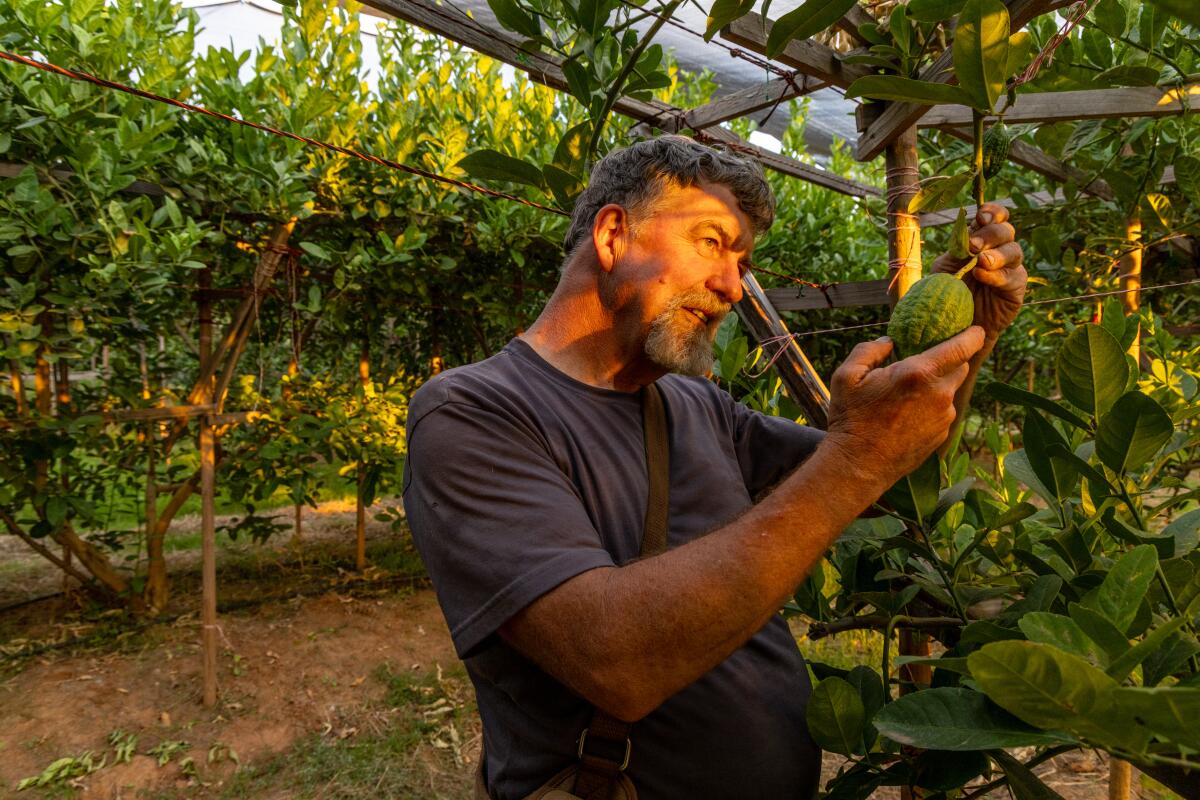
Whether or not you are celebrating the Jewish harvest holiday Sukkot this week, you’ll likely find reporter Daniel Miller‘s story on citron fascinating. The lumpy and ancient citrus, known as etrog in Hebrew, is an essential part of the daily blessing ritual during Sukkot and, as Miller reports, one single farm in Exeter, Calif., has supplied the citron for most Jews in the U.S. for some 40 years. Citron grown by Lindcove Ranch can cost up to $100 each and must adhere to strict kosher laws — among them, Miller writes, “no insect nibbles allowed.” This year’s crop was especially difficult due to the torrential rains that hit the farm in January. Miller’s suspense-filled tale details how the ranch’s Greg Kirkpatrick overcame the challenges — and how his family became the growers for the country’s citron for Sukkot.
The hidden pedigree of Louise’s Trattoria
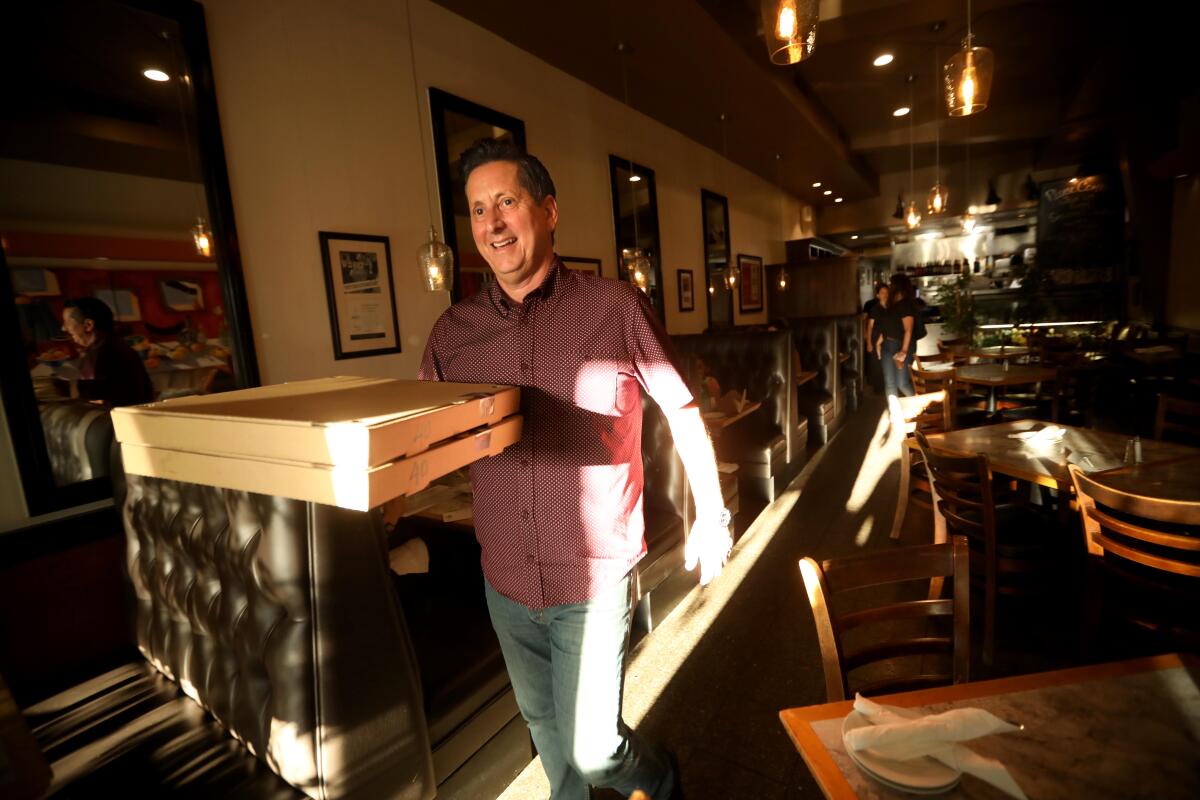
Miller wrote another food story last week, one that digs into L.A. history and reveals a fascinating fact about the Italian food chain Louise’s Trattoria, which once had 19 restaurants across the country and now has just one remaining location in Los Angeles’ Larchmont Village. The chain started in Santa Monica as a pizzeria in 1978 and became the first acquisition of budding restaurant czar Bill Chait in the mid-1980s. Perhaps spurred in part by a 1993 review in this paper by now-novelist Michelle Huneven with the headline “Growing Pains Take Their Toll at Louise’s,” Chait brought on the legendary Italian restaurateur Mauro Vincenti as a consultant in 1994. One guiding principle for Vincenti, who died in 1996, was that at least one Italian with knowledge of the cuisine should be in every Louise’s kitchen. That’s how Louise’s became the improbable first L.A. stop for Angelini Osteria‘s Gino Angelini. Miller reports, “Nicola Mastronardi of the recently closed Vincenti Ristorante [and] Lucio Bedon of the newly opened Vicini Ristorante & Wine Bar” had stints at Louise’s. “Guy Fieri even worked there as a district manager.”
Grand Central Market gets Villa’s Tacos
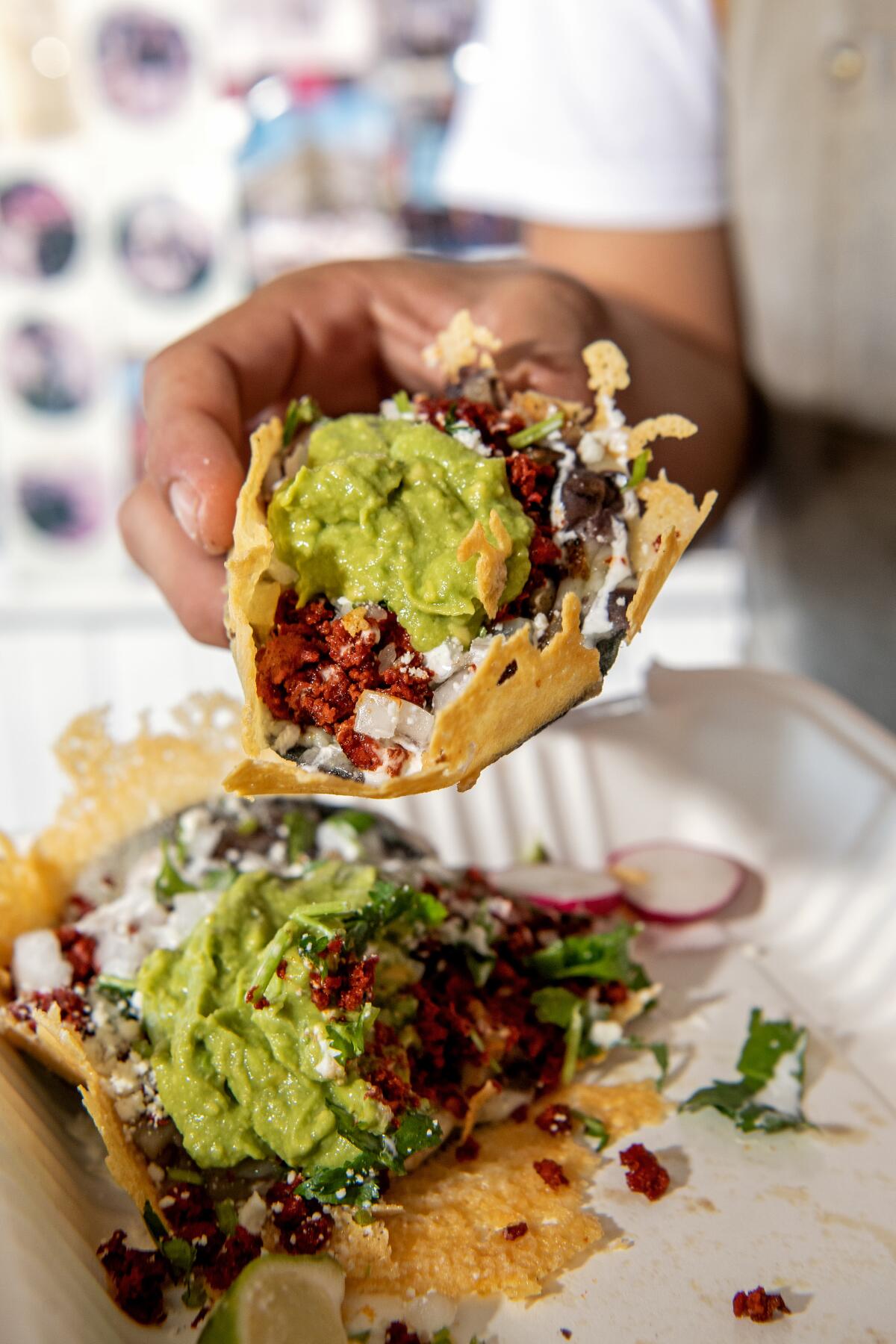
There’s new life in the old Belcampo space at L.A.’s Grand Central Market. It’s been nearly two years since the now-defunct restaurant, farm and butchery operation shut down — after revelations in an employee social media post that the company was selling outside purveyors’ products as its own organic, farm-raised meat. (For an illuminating analysis about the difficulty of raising organic, pasture-raised beef — a slow-food process in a fast-finish world — read Beth Hoffman‘s “What the Meat Industry Can Learn From the Downfall of Belcampo” in Civil Eats.)
Now, as Stephanie Breijo reports in her Quick Bites column this week, Villa’s Tacos, the Highland Park pop-up turned Michelin Bib Gourmand sensation, is taking over the long-empty Belcampo space. In an interview with Breijo, owner Victor Villa (whose style critic Bill Addison says “epitomizes ... the L.A. dreamer, the go-getter”) talked about the meaning of being in Grand Central Market and how the space might inspire some experimentation: “Because we’re gonna have more room to cook, we’re gonna have more room to play with our menu. Maybe throw people a curveball.” That could mean a weekend special of barbacoa, Breijo writes, or maybe a rainy-day caldo de res.
More openings: Breijo also writes that the pandemic-born pop-up Calic Bagel, centered around Alex and Sun Sohn‘s signature bagel with a garlicky butter and cream cheese center, has a new shop called MarkEAT 8 and plans for more eating places to fill the space. ... Katianna and John Hong‘s Yangban Society is now just Yangban with a renovated space and refocused menu “riffing on the couple’s fine-dining pedigrees that include Mélisse, where they met,” Breijo writes. ... Parakeet Cafe, which has locations in San Diego and Orange County, has opened its first L.A. County restaurant in Beverly Hills serving grain bowls, tartines, tapas and salads. ... Madre, “Ivan Vasquez’s temple to Oaxacan cuisine and agave, has expanded again,” Breijo writes, this time into Santa Clarita. ... HomeState has opened two new spots, one in Atwater and one in Culver City. That makes eight places around Southern California to get its great Texas-style breakfast tacos and migas. ... And Mama’s Night Market returns to downtown L.A. for a Saturday night music and street food party on San Pedro near 9th Street with Evil Cooks, Holy Basil, Heng Heng Chicken Rice and more.
Grape nuts
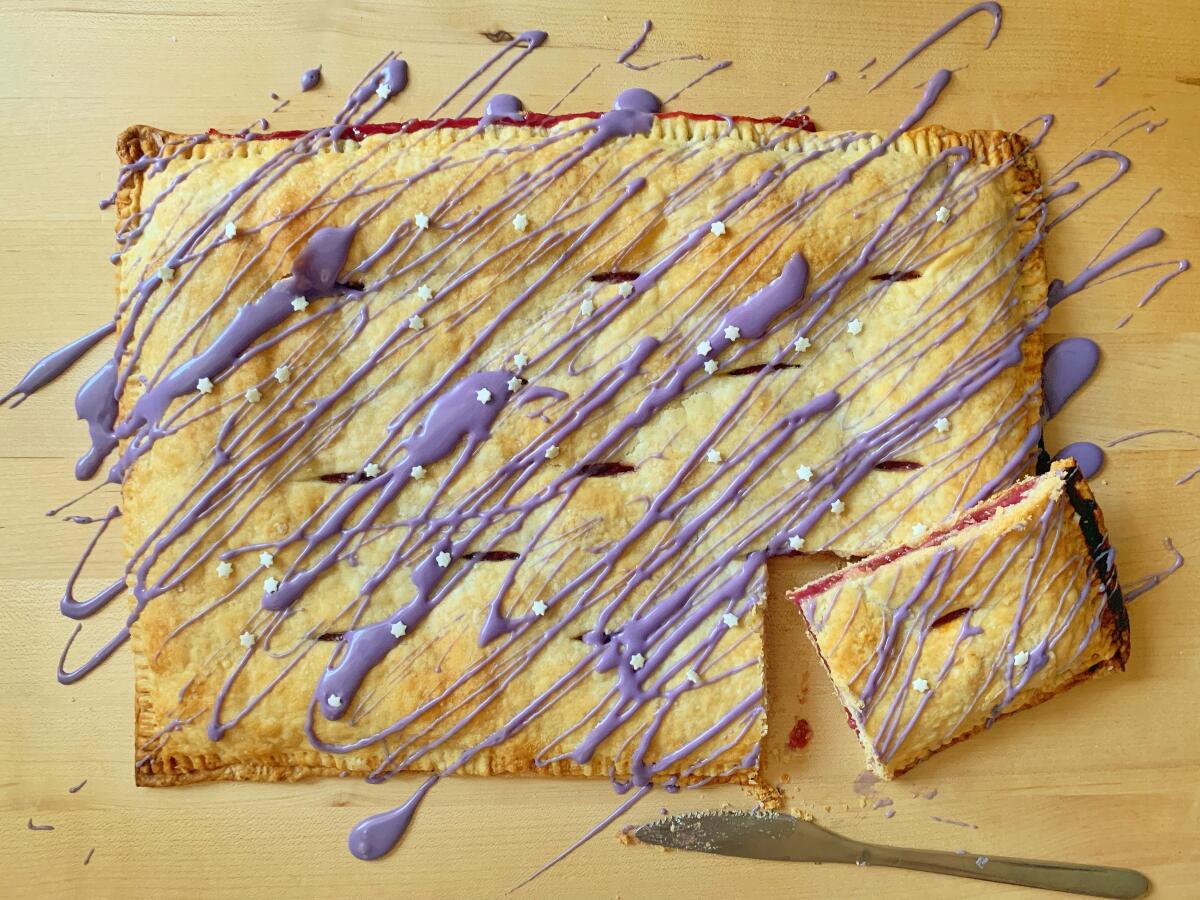
I love that a grape Pop-Tart inspired cooking columnist Ben Mims to create his Thomcord Grape Sheet Tart with cooked-down, jammy grapes baked “until crisp and buttery” between two pie dough sheets. And because we are in the midst of grape season, he also shares his great Thomcord Grape and Corn Cake from last year in his most recent column on early fall cooking.

Keeping it healthy
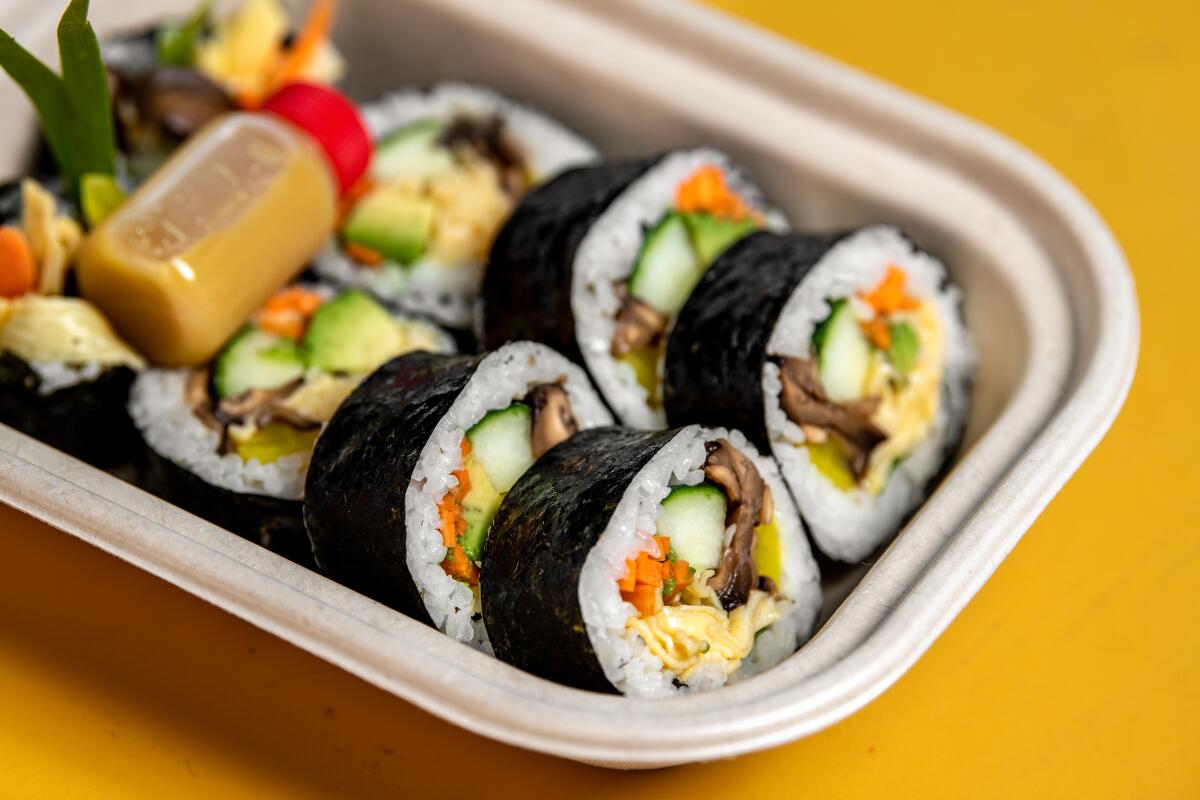
“If you follow me on Instagram,” Jenn Harris writes in her newest column, “my diet might seem like a monochrome spectrum of brown food. And for the most part, it can be. But what you don’t see are the healthful meals I try to squeeze in.” This week, Jihee Kim’s banchan at Perilla L.A., especially a jangajji-style pickle with charred okra, plus a build-your-own Vietnamese rice and salad bowl from the newest My Lai location in West Hollywood, fed Harris’ vegetable cravings for the week. And if you missed it, Bill Addison reviewed Perilla L.A. last week, calling it “a vital new daytime destination.”
Have a question?
Also ...
- An excellent look at the risks and benefits of nighttime harvesting for farmworkers, who avoid extreme heat but face other threats, by Amy Mayer in Civil Eats.
- Finally, love it or hate it, pumpkin spice season has arrived. Food’s Danielle Dorsey and Stephanie Breijo have a guide to some of the best coffee spots to get your shot of pumpkin spice, or autumn in a cup.
Eat your way across L.A.
Like what you're reading? Sign up to get it in your inbox every week.
You may occasionally receive promotional content from the Los Angeles Times.
It's a date
Get our L.A. Goes Out newsletter, with the week's best events, to help you explore and experience our city.
You may occasionally receive promotional content from the Los Angeles Times.


